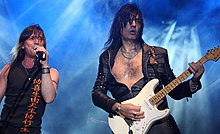Rata Blanca
| Rata Blanca | |
|---|---|
 |
|
| Background information | |
| Origin | Buenos Aires, Argentina |
| Genres | Heavy metal, power metal, neoclassical metal, hard rock |
| Years active | 1986–1997, 2000–present |
| Website | http://www.ratablanca.net/ |
| Members |
Adrián Barilari Fernando Scarcella Walter Giardino Guillermo Sánchez Danilo Moschen |
| Past members | Saúl Blanch Gustavo Rowek Sergio Berdichevsky Hugo Bistolfi Gabriel Marian Javier Retamozo Mario Ian |
Rata Blanca (White Rat in English) is a heavy metal band from Argentina formed in 1986.
The guitarist Walter Giardino replaced Osvaldo Civile in V8 for a little time, and left the band when his songs were rejected. His friend Roberto Cosseddu, bassist of Kamikaze, helped him to record a demo tape with those songs. The drummer Gustavo Rowek, who had also left V8 a short time before, declined his projects with Civile and joined Giardino. The session musicians Rodolfo Cava (singer) and Yulie Ruth (bass player) completed the line-up that recorded the demo. The songs were "Chico callejero", "Rompe el hechizo", "Gente del sur" and "La bruja blanca". Seeking stable members, the band took Saúl Blanch as singer, who was working in the hard rock band Plus. They met the bass player Guillermo Sánchez with the help of Giardino's friend Sergio Berdichevsky, member of WC at that point.
Rata Blanca made their first concert on August 15, 1987 in the Luz y Fuerza theater. Saúl Blanch left the band, and he was replaced by Carlos Périgo, who composed the song "Días Duros". Périgo left the band soon after that. Rodolfo Cava returned for a brief time, and Shito Molina got ill and could not sing anymore. As the band was about to record their first album and needed a singer immediately, Saúl Blanch returned to the band and helped record it. The album Rata Blanca was released in 1988, with nine songs. On that year they took part in the "Halley en Obras" concert, along with Alakrán, JAF and Kamikaze.
Polygram requested that the band could create an album which would have high sales in the first semester to renew the contract, and the band made fourfold the required number of sales. The keyboard player Hugo Bistolfi joined the band in 1989, and the singer Adrián Barilari replaced Saúl Blanch. The band subsequently made their second album Magos, espadas y rosas, which contained the popular songs "Mujer amante" and "La leyenda del hada y el mago". It was a successful release, and in its wake the band appeared in the TV show Ritmo de la Noche, and played in cumbia concert halls because typical rock venues could not accommodate their large audiences.
...
Wikipedia
